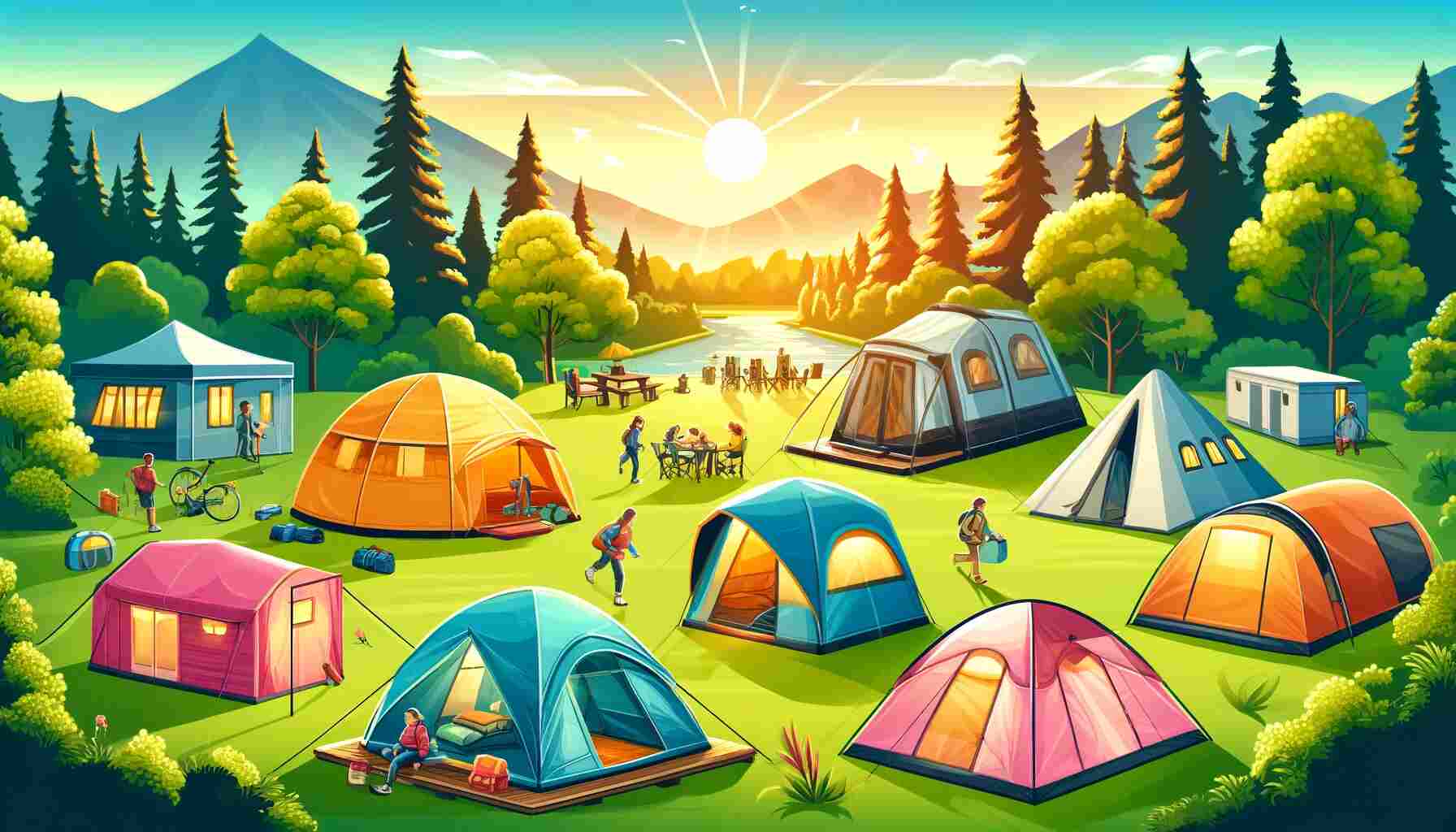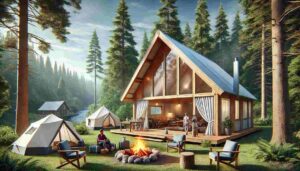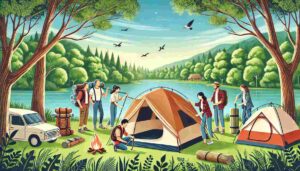A crucial aspect of a successful camping experience is choosing the right tent. With a variety of tent types available, it can be overwhelming to select the best one for your needs. This comprehensive guide explains the different types of camping tents, their unique features, and their ideal uses to help you make an informed decision.
1. Dome Tents
Overview
Dome tents are among the most popular types of tents due to their versatile design and ease of setup. They are characterized by two or more flexible poles that cross in the center, creating a dome shape.
Features
- Shape: The dome shape provides excellent wind resistance and stability.
- Space: Typically offers ample headroom and floor space, making them suitable for small to medium groups.
- Weight: Generally lightweight, making them easy to transport.
- Setup: Quick and straightforward to set up, even for beginners.
Ideal Uses
Dome tents are perfect for car camping, weekend getaways, and short backpacking trips. They work well in most weather conditions but may not be the best choice for extreme weather.
Popular Models
- Coleman Sundome Tent: A reliable and affordable option for casual campers.
- Marmot Limestone 4P: Offers more space and durability for family camping trips.
2. Cabin Tents
Overview
Cabin tents are designed to resemble small cabins, offering vertical walls and a high ceiling. This design maximizes interior space and comfort, making them ideal for family camping.
Features
- Shape: Vertical walls provide more usable interior space.
- Space: Often spacious enough to accommodate larger groups and tall campers.
- Weight: Heavier and bulkier, making them less suitable for backpacking.
- Setup: More complex to set up, often requiring two or more people.
Ideal Uses
Cabin tents are best suited for family camping trips, extended stays at a campsite, and situations where comfort and space are a priority. They are excellent for summer camping but may struggle in high winds and heavy rain.
Popular Models
- CORE 9 Person Instant Cabin Tent: Spacious and easy to set up, perfect for family camping.
- Eureka Copper Canyon LX 8-Person Tent: Offers excellent space and durability for large groups.
3. Tunnel Tents
Overview
Tunnel tents feature a series of arched poles that create a tunnel-like structure. This design provides a good balance between stability, space, and weight.
Features
- Shape: Tunnel design offers excellent wind resistance when pitched correctly.
- Space: Provides generous living space and headroom.
- Weight: Generally lightweight and compact when packed.
- Setup: Requires proper staking for stability, but setup is relatively easy.
Ideal Uses
Tunnel tents are ideal for backpacking, cycling tours, and family camping trips. They perform well in windy conditions and offer a good compromise between weight and space.
Popular Models
- Hilleberg Nallo 2 GT: Known for its durability and spacious vestibule, perfect for serious backpackers.
- Vango Omega 350: Offers a great balance of space, weight, and affordability.
4. Backpacking Tents
Overview
Backpacking tents are specifically designed for hikers and backpackers who prioritize weight and packability. These tents are lightweight, compact, and often minimalist in design.
Features
- Weight: Extremely lightweight, often under 4 pounds for a two-person tent.
- Space: Compact and may be snug for two people, focusing on minimalism.
- Setup: Quick and straightforward, with an emphasis on efficiency.
- Durability: Made from high-quality materials to withstand various weather conditions.
Ideal Uses
Backpacking tents are perfect for long-distance hikers, solo adventurers, and anyone needing a lightweight shelter for extended trips. They are designed to perform well in diverse weather conditions.
Popular Models
- Big Agnes Copper Spur HV UL2: Highly popular for its balance of weight, space, and durability.
- NEMO Hornet Elite: Ultra-lightweight and compact, ideal for solo backpackers.
5. Pop-Up Tents
Overview
Pop-up tents, also known as instant tents, are designed for convenience and ease of use. These tents can be set up in seconds, making them popular for casual camping and festivals.
Features
- Setup: Instantly pops open when removed from its bag, requiring minimal effort.
- Weight: Generally lightweight and easy to carry.
- Space: Suitable for small groups, but space can be limited.
- Durability: Often made from less robust materials, not ideal for harsh conditions.
Ideal Uses
Pop-up tents are perfect for beginners, festival-goers, and casual campers who prioritize convenience. They are best used in mild weather and for short trips.
Popular Models
- Quechua 2 Seconds XL: Renowned for its easy setup and decent space for two people.
- Coleman 2-Person Pop-Up Tent: Affordable and practical for quick getaways.
6. Inflatable Tents
Overview
Inflatable tents, also known as air tents, use air-filled beams instead of traditional poles. This modern design simplifies the setup process and provides a sturdy structure.
Features
- Setup: Quick and easy, using an air pump to inflate the beams.
- Weight: Can be heavier due to the air beams and pump.
- Space: Offers good interior space and headroom.
- Durability: Sturdy and stable, with excellent wind resistance when properly inflated.
Ideal Uses
Inflatable tents are ideal for family camping and car camping where quick setup and stability are essential. They perform well in various weather conditions but require an air pump for setup.
Popular Models
- Vango Odyssey Air 600: Offers ample space and quick setup for family camping.
- Coleman Valdes Deluxe 6XL: Spacious and durable, perfect for larger groups.
Quick Comparison Table
| Type | Ideal Use | Key Features | Popular Models |
|---|---|---|---|
| Dome Tents | Car camping, weekend trips | Versatile, stable, easy setup | Coleman Sundome Tent, Marmot Limestone 4P |
| Cabin Tents | Family camping | Spacious, vertical walls, comfortable | CORE 9 Person Instant Cabin Tent, Eureka Copper Canyon LX 8-Person Tent: |
| Tunnel Tents | Backpacking, cycling tours | Wind-resistant, spacious, lightweight | Hilleberg Nallo 2 GT, Vango Omega 350: |
| Backpacking Tents | Long-distance hiking | Lightweight, compact, durable | Big Agnes Copper Spur HV UL2, NEMO Hornet Elite |
| Pop-Up Tents | Festivals, casual camping | Instant setup, lightweight, convenient | Quechua 2 Seconds XL, Coleman 2-Person Pop-Up Tent |
| Inflatable Tents | Family camping, car camping | Quick setup, sturdy, spacious | Vango Odyssey Air 600, Coleman Valdes Deluxe 6XL |
When selecting a tent, consider factors such as the number of people, the type of camping, the expected weather conditions, and the ease of setup.
Conclusion
Choosing the right camping tent is essential for a comfortable and enjoyable outdoor experience. Understanding the different types of tents and their features will help you make an informed decision based on your specific needs and preferences. Whether you’re a solo backpacker, a family camper, or a festival-goer, there’s a tent out there that’s perfect for you.
Happy camping!










